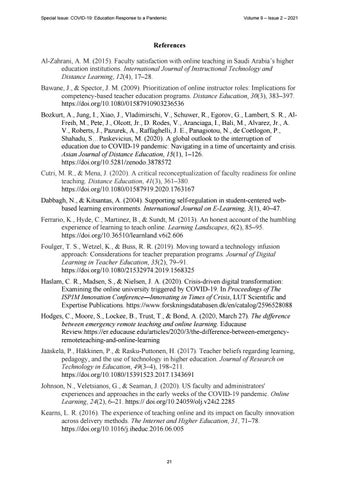Special Issue: COVID-19: Education Response to a Pandemic
Volume 9 – Issue 2 – 2021
References Al-Zahrani, A. M. (2015). Faculty satisfaction with online teaching in Saudi Arabia’s higher education institutions. International Journal of Instructional Technology and Distance Learning, 12(4), 17–28. Bawane, J., & Spector, J. M. (2009). Prioritization of online instructor roles: Implications for competency-based teacher education programs. Distance Education, 30(3), 383–397. https://doi.org/10.1080/01587910903236536 Bozkurt, A., Jung, I., Xiao, J., Vladimirschi, V., Schuwer, R., Egorov, G., Lambert, S. R., AlFreih, M., Pete, J., Olcott, Jr., D. Rodes, V., Aranciaga, I., Bali, M., Alvarez, Jr., A. V., Roberts, J., Pazurek, A., Raffaghelli, J. E., Panagiotou, N., de Coëtlogon, P., Shahadu, S…Paskevicius, M. (2020). A global outlook to the interruption of education due to COVID-19 pandemic: Navigating in a time of uncertainty and crisis. Asian Journal of Distance Education, 15(1), 1–126. https://doi.org/10.5281/zenodo.3878572 Cutri, M. R., & Mena, J. (2020). A critical reconceptualization of faculty readiness for online teaching. Distance Education, 41(3), 361–380. https://doi.org/10.1080/01587919.2020.1763167 Dabbagh, N., & Kitsantas, A. (2004). Supporting self-regulation in student-centered webbased learning environments. International Journal on E-Learning, 3(1), 40–47. Ferrario, K., Hyde, C., Martinez, B., & Sundt, M. (2013). An honest account of the humbling experience of learning to teach online. Learning Landscapes, 6(2), 85–95. https://doi.org/10.36510/learnland.v6i2.606 Foulger, T. S., Wetzel, K., & Buss, R. R. (2019). Moving toward a technology infusion approach: Considerations for teacher preparation programs. Journal of Digital Learning in Teacher Education, 35(2), 79–91. https://doi.org/10.1080/21532974.2019.1568325 Haslam, C. R., Madsen, S., & Nielsen, J. A. (2020). Crisis-driven digital transformation: Examining the online university triggered by COVID-19. In Proceedings of The ISPIM Innovation Conference—Innovating in Times of Crisis, LUT Scientific and Expertise Publications. https://www.forskningsdatabasen.dk/en/catalog/2596528088 Hodges, C., Moore, S., Lockee, B., Trust, T., & Bond, A. (2020, March 27). The difference between emergency remote teaching and online learning. Educause Review.https://er.educause.edu/articles/2020/3/the-difference-between-emergencyremoteteaching-and-online-learning Jääskelä, P., Häkkinen, P., & Rasku-Puttonen, H. (2017). Teacher beliefs regarding learning, pedagogy, and the use of technology in higher education. Journal of Research on Technology in Education, 49(3–4), 198–211. https://doi.org/10.1080/15391523.2017.1343691 Johnson, N., Veletsianos, G., & Seaman, J. (2020). US faculty and administrators' experiences and approaches in the early weeks of the COVID-19 pandemic. Online Learning, 24(2), 6–21. https:// doi.org/10.24059/olj.v24i2.2285 Kearns, L. R. (2016). The experience of teaching online and its impact on faculty innovation across delivery methods. The Internet and Higher Education, 31, 71–78. https://doi.org/10.1016/j.iheduc.2016.06.005
21



